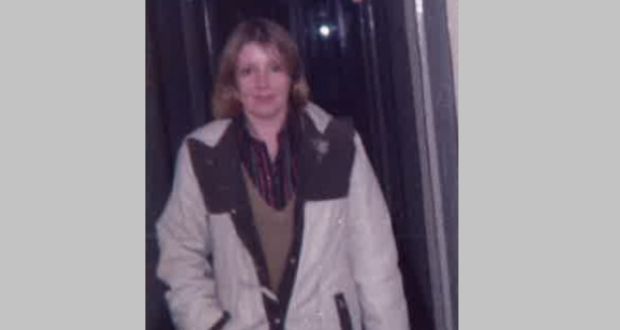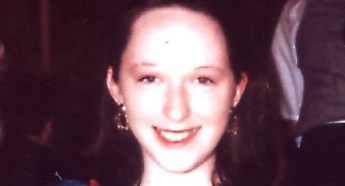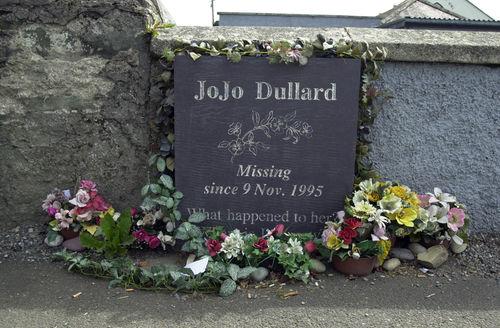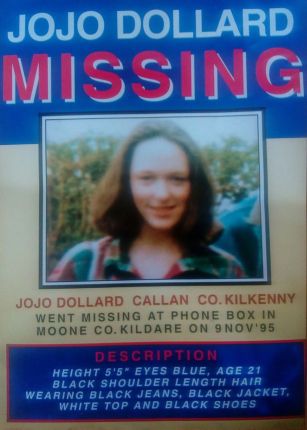The Vanishing Triangle
In the mid to late 1990s, several disappearances of women occurred in the eastern part of Ireland. All women were young and disappeared suddenly without much clues to enable investigators to discern their fate. Large scale searches and campaigns by the Gardaí were to no avail. A popular hypothesis is that a serial killer, or killers, may have been operating in this area at the time.
The unofficial list names six missing women, however it is debated that this list should contain a lot more. The disappearances occurred within a wide, sort of triangular area, giving to the mysterious name ‘The Vanishing Triangle’.
The Missing Six
Annie McCarrick
Annie McCarrick was a shy and trusting 26 year old brunette student from Long Island, New York, who had been living in Sandymount, Co. Dublin, for some time. Annie had come to Ireland in 1990 to study literature at the National University of Ireland, Maynooth. She had worked part-time in a restaurant and shared a flat with two Irish women.
Annie had invited her friend Hilary Brady and his girlfriend Rite Fortune to dinner on 26th March 1993, however when they arrived Annie was not there. Shortly after, they contacted her parents John and Nancy McCarrick in New York and they reported her missing.
Earlier on the 26th, Annie’s flatmates had asked her what her plans for the weekend were and Annie said she was planning on going for a walk in Enniskerry, Co. Wicklow. Annie called a friend to see if she would like to join her on the walk, but the friend was unavailable. She continued with her plan and the last confirmed sighting of Annie was on the number 44 bus she had boarded at 3.30pm where a co-worker spotted her going to the upstairs section of the bus.
Later on, there was an unconfirmed sighting of Annie in Glencullen, Dublin, where a doorman of Johnny Fox’s pub stated that Annie was there accompanied by an unknown man in both the lounge and the cabaret room of the pub where the man had paid entrance fee into.
The McCarricks arrived in Ireland shortly after Annie was reported missing and stayed for 6 months searching unsuccessfully for their daughter.
Josephine ‘Jo Jo’ Dollard
Josephine Dollard, known as JoJo to her friends and family, was a blue eyed, black haired, 21-year-old beautician from Cuffsgrange, Co. Kilkenny. On 09th November 1995, JoJo was making her way home from Dublin to Callan, Kilkenny. JoJo had travelled to Dublin to sign off from the dole, Ireland’s unemployed benefit scheme, as she had got a job in Graingers’ restaurant in her home town, after previously leaving her beauticians job some time earlier, and was due to start work the next morning.
After missing the direct bus home from Dublin, she took a commuter bus to Naas and began hitching her way home from there. She had been driven to Kilcullen and from there to Moone. She was last seen making a phone call to her friend, Mary Cullinane, at 11.37pm from a telephone box in the village of Moone, Co. Kildare. She rang her friend to let her know she was having difficulty getting a lift and whilst on that call a car pulled up. A short time later, a woman similar to JoJo’s description was seen leaning in the back door of a dark coloured Toyota Carina type car. The occupants of this car have never been traced.
There was also an unconfirmed sighting of JoJo walking along a road in Castledermot, Co Kildare. Gardai tried to trace a man in his 20s who was seen buying chips near this time in a diner. It believed that she was abducted between 11.50pm and 12.05am. Gardai urged farmers in the area to search their land.
In 1996, JoJo’s sister Mary Phelan and her Husband Martin hired their own private investigator. The investigator pretended to be a tourist looking for directions to gain access to the farmland of a man they believe killed JoJo. He met a man who had a scar on his face which hadn’t healed well due to lack of medical attention. The investigator added that he was after solving 13 murders but ‘Jojo’s I’ll never solve.. I’ll have to bring that one to my grave with me’. Two female Gardai who were sent to Mary’s house to visit them did not even have it in their files that the chief suspect had a scar. JoJo’s family claim the killer is related to a politician and that this influence has protected him as the Gardai ‘know who it is, but they’re not going to do anything about it now’ and that a senior officer told them that ‘the investigation will go nowhere’.
Shortly after her disappearance, a woman wrote a letter to the family stating that she was an ex-girlfriend of the suspected killer and that he has abused her during their relationship. Her sister Mary brought the letter straight to Baltinglass Garda station which she later regretted as she later stated that ‘I know now they were never going to act on that letter’. She unfortunately did not get a photocopy of the letter before handing it over. JoJo’s sister Mary said that the investigation was a ‘complete mess’. There is also claims that there was a smear campaign ran to destroy her character which resulted in the public and some politicians defending her honour.
Ciara Breen
Ciara Breen was an 18 year old from Dundalk, Co. Louth.
On 13th February 1997, Ciara and her mother, Bernadette, had gone to bed just after midnight. At 2am, Bernadette had got up to use the bathroom and realised that Ciara was no longer in her bed. The bedroom window was left on the latch, leading the belief that Ciara had snuck out of the house through the front door for a pre-arranged meeting, leaving the window open so she could climb back in later. Ciara did not bring any money or clothes with her.
In 2014, two witnesses came forward with sightings of Ciara from the night she disappeared leading to an arrest of a man in his 50s in 2015, but he was not charged with a crime. This arrest led to the search of an area called Balmer’s Bog in August and September of 2015, but no traces of Ciara could be found. The search was then called off with nothing found except old bomb components. This suspect had been previously arrested in 1999 over Ciara’s disappearance as witness claimed that Ciara had snuck out of the house to meet him, but he maintained his innocence up until his death in 2017.
Fiona Pender
Fiona Pender from Tullamore, Co. Offaly was a 25 year old hairdresser and part-time model who went missing on 23rd August 1996. Fiona was seven months pregnant at the time of her disappearance and was last seen leaving her apartment by her Boyfriend John Thompson.
On the border between counties Laois and Offaly is the Slieve Bloom Way which is a long-distance trail circling the Slieve Bloom Mountains. In 2008, a small wooden cross was discovered bearing Fiona’s name, leading to the belief that Fina was buried in the mountains.
A man known to the Pender family has been the chief suspect in Fiona’s disappearance, but Gardai have arrested several people and searched different areas of lands. In the last few years, a woman living outside of Ireland has told Gardai that while in a rage her husband had threatened her and implied that he had killed Fiona and would kill her also. The woman described an area where she believed Fiona’s body was buried however the information came to nothing and no conviction was brought against her husband.
Although still technically a missing person, Fiona is presumed murdered and if this was under less devastating circumstances, Fiona’s unborn child would be now in his or her 20’s. A sad reminder that is case involves the disappearances of two people, not just one.
Fiona Sinnott
Fiona Sinnott from Rosslare, Co. Wexford was a 19 year old mother of one who went missing on 8th February 1998.
Fiona was last seen leaving a local pub with her ex-boyfriend Sean Carroll in Broadway, Co. Wexford where she had been living. Carroll told those investigating her disappearance that he had walked Fiona back to her house and spent the night sleeping on the couch. The next morning Fiona, who has been complaining of pains in her upper body previously, said that she intended on hitching a lift to her physician later that day about the pains. After finding out she had no money, Carroll gave her £3 and left her house to his mother waiting outside in a car for him to go home. Fiona and Sean Carroll’s daughter Emma had been staying in the Carroll’s at that time.
Fiona never attended her physician’s office that day or any other doctors in fact and no witnesses came forward to prove that she had even attempted to hitch a lift. Fiona’s house had not much personal belongings and the house did not look like that of a teenager’s and child’s house. A farmer came forward to Gardai stating that he had found a number of black sacks containing personal items from Fiona, including documents with her name on them. But the farmer had destroyed the bags as he was under the impression that they were being illegally dumped, a major issue faced in Ireland still to this day. It was speculated that someone may have tried to stage the house as if Fiona had run away. Some speculated that Fiona had run away to England after a brief relationship with an English lorry driver however he was tracked down and Fiona was not in his company and was then ruled out as a suspect. Those who knew Fiona knew the likelihood of her running away was small because her daughter Emma was the centre of her universe and she would not have left her.
Deirdre Jacob
Deirdre Jacob from Newbridge, Co. Kildare was an 18 year old who was studying at St. Mary’s University and living in Twickenham, London. Deirdre had been home for the summer after completing her first year as a student teacher and on 28th July 1998 disappeared just yards from her parents’ home. She was last sighted walking within yards of her parent’s driveway but never made it to the house. Deirdre had been visiting her grandmother and running errands before walking home.
An Irish prisoner alleged that convicted Irish rapist, Larry Murphy, had confessed to him about abducting Deirdre and last year, roughly seven years after the first allegation, Gardai interviewed the prisoner again for more information.
Deirdre’s disappearance has been upgraded to a murder enquiry because of new not yet released information, with several persons of interest alongside Murphy, however no convictions have been made as of yet.
A longer list than six?
Eva Brennan
Eva Brennan from Rathgar, Co. Dublin was 39 when she disappeared on 25th July 1993. Eva was last seen in her parent’s house where she attended a family lunch. Two days after this lunch Eva’s father went to her apartment as they had not seen her since the lunch. Ava’s family were possibly worried due to the fact that Ava had been depressed prior. After ringing the doorbell and getting no answer Eva’s father went to the pub the family owned, The Horse and Hound, and asked a barman to come with him. They went back to Eva’s house and together broke a window to get in. There was no sign of Ava however the jacket she had been wearing on the day of the family lunch was there, indicating that she had returned to her apartment since the lunch.
Gardai have been criticised on their handling of Eva’s disappearance as no investigation was initiated until around three months after the disappearance.
Imelda Keenan
Imelda Keenan from Mountmellick, Co. Laois was a 22 year old student who went missing on 3rd January 1994. Imelda was living with her boyfriend Mark Wall in Waterford City and on the day which she disappeared had told Wall that she was going to go to the post office. She left the apartment at 1.30 pm and was last seen by a doctor’s secretary while crossing the road near the Tower Hotel.
Theories
Since Fiona Sinnott’s disappearance in 1998, no other cases have been classed as of such an unexplained nature to be warranted addition to the list.
A main theory and briefly mentioned above is the involvement of convicted serial rapist Larry Murphy who was also convicted of attempted murder of his victims. Murphy who is from an area within the ‘triangle’ was convicted and imprisoned in 2001 for the rape and attempted murder of a woman in 2000. Murphy was attempting to strangle the woman in the Wicklow mountains but was foiled by two hunters who came upon the scene and saved the woman.
Although there is no actual evidence linking Murphy to the disappearances and he has maintained his innocence, Murphy is a suspect in the disappearances of Annie McCarrick, Jo Jo Dollard and Deirdre Jacob.
Operation Trace
Operation Trace is an initiative, set up in 1998, focused on solving unsolved disappearances including those mentioned above and has even offered a €10,000 reward for information which results in a discovery of a body. It is unfortunate that monetary value has to be put on information pertaining to a case, however if a reward entices someone to give valuable information of which they would have previously kept secret and a family gets answers and closure, who am I to question it. Operation trace drafted in two FBI agents to assist in the operation and together with the National Bureau of Criminal Investigations (NBCI) they examined the files on the missing women. The agents specialised in profiling serial killers and rapists.
Despite an extensive investigation by the Gardai, Operation Trace, the public and family, these women or their abductors have never been truly identified. Although we may never know what happened to them, someone out there does.









